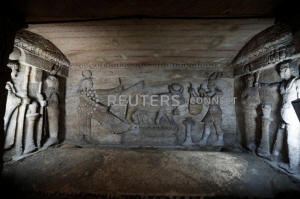|
The
restoration, which began in late 2017, was completed using a
$5.7 million grant from the U.S. Agency for International
Development (USAID). The grant also covered maintenance and
training for ministry employees.
"The antiquity underwent many restoration projects, the most
important of which was in the mid-nineties, which was an
ambitious project supervised by the Supreme Council of
Antiquities," Antiquities Minister Khaled al-Anani said from the
site on Sunday.
"But unfortunately, the water returned once again and complaints
rolled in from parliamentarians, tour guides and archaeologists,
which is what pushed us to act in cooperation with USAID."
The catacombs are unique, mixing ancient Egyptian and
Greco-Roman architectural styles. They were carved into the rock
on three levels. The ground level was damaged by water from
nearby farmland and a canal, as well as sewage water.
The antiquities ministry has previously cooperated with USAID on
several groundwater-removal projects in Cairo, Giza, Luxor and
Aswan.
Al-Anani said a similar project will be opened on March 25 at
Kom Ombo in Aswan governorate.
Egypt has been working to revive its tourism industry - a key
source of foreign currency - which was badly hit after the 2011
popular uprising that unseated Hosni Mubarak and was further
hampered by a spate of militant attacks that sometimes targeted
visitors.
(Reporting by Amr Abdallah Dalsh; Writing by Yousef Saba;
editing by David Evans)
[© 2019 Thomson Reuters. All rights
reserved.] Copyright 2019 Reuters. All rights reserved. This material may not be published,
broadcast, rewritten or redistributed.
Thompson Reuters is solely responsible for this content.

|
|






